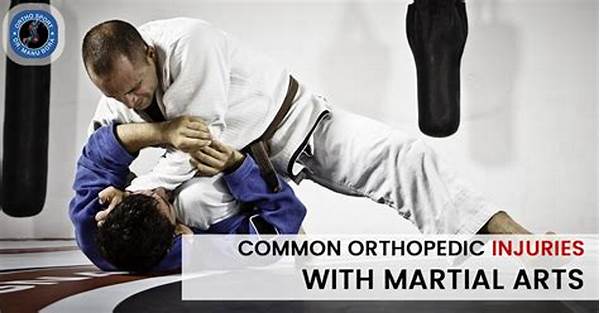Common Injuries In Martial Arts

- Understanding the Risks: Types of Common Injuries in Martial Arts
- Guarding Against the Unseen: Preventative Measures
- Common Injuries in Martial Arts: Prevention Insights
- Through Thick and Thin: Motivational Tales
- Exploring Common Injuries: Details and Context
- Concluding Thoughts: The Martial Path Forward
Imagine embarking on a journey of discipline, power, and grace — welcome to the world of martial arts. Whether you are drawn in by the martial prowess of Bruce Lee or the meditative calm portrayed through Tai Chi, there’s a unique martial art for everyone. It’s a realm of self-discovery, an arena where mental toughness meets physical endurance. Yet, amid the flurry of kicks and punches, the reality of injuries looms large. Like any sport or physical activity, martial arts carry the risk of certain injuries that can hinder one’s journey. So, let’s delve into the world of common injuries in martial arts, not to scare you off, but to prepare you to manage and even prevent them.
Read More : Benefits Of Roller Skating
From the humorous mishaps in dojos to inspiring recovery stories, injuries are an inevitable part of martial arts. They can form anecdotes of resilience, chapters in your personal martial art story. I’m not here just to list injuries like an instruction manual; instead, I aim to transform this knowledge to captivate attention, kindle interest, and foster a powerful desire within you to master your practice—injury-free. So gear up, martial artists, as we unravel these common martial arts injury mysteries and arm you with the wisdom to tackle them head-on.
Understanding the Risks: Types of Common Injuries in Martial Arts
In martial arts, injuries range from the ordinary to the ‘write-home-to-mom’ extraordinary. You have your standard fare of bruises and scrapes, often worn like badges of honor. On the opposite end, more serious injuries like fractures or concussions demand attention.
Bruises and Cuts: The Rookie’s Battle Scars
Let’s start with the basics—bruises and cuts, often considered the ‘love bites’ from your practice session. These are so common in martial arts that it’s almost a rite of passage. You take a hit; you bruise; you learn. It’s not just the sparks flying in a sparring match; it’s learning the angle of your opponent’s punch. However, gaining these warrior tattoos does require proper care—clean them, cover them, and wear them with pride.
Sprains and Strains: Flexibility’s Kryptonite
Perhaps your diligent pursuit of the perfect head-kick leaves you in a tendon-tensioning split. Sprains and strains are the classic traps for both beginners and veterans alike, often due to overexertion or improper technique. Remember, flexibility isn’t about unnatural contortions; it’s about mastering movement fluidly. Engage in appropriate warm-ups, because honestly, you aren’t an action figure.
Fractures: When Bone Crunches Become Real
Then come the fractures—for when life decides your bones should play the xylophone. High-impact throws or kicks, though exhilarating, can sometimes culminate in bone fractures. Here, prevention via learning fall techniques (Ukemi, anyone?) becomes paramount and your steady companion in sparring matches.
Guarding Against the Unseen: Preventative Measures
Preventing injuries is far from sorcery—it’s effective planning. A sound training regime, constant communication with instructors about your limits, and engagement in proper recovery practices are crucial.
Training Smart, Not Hard
Engage your interest with tailored training programs focusing on technique refinement. Admit it; perfectionism can be the unsung villain here. It isn’t just about striking harder and faster.
Proper Gear: Your Silent Partner
Remember your gear isn’t just to impersonate a sci-fi character. It stands as your personal shield. Helmets protect your cranium, pads safeguard your shins, and mouthguards? Well, your smile is prime real estate.
Common Injuries in Martial Arts: Prevention Insights
Let’s consider some actionable steps you might take on this martial journey:
Read More : Basic Ollie Technique On A Skateboard
Through Thick and Thin: Motivational Tales
Martial arts isn’t just about the punches, but the ethos you embody outside the dojo. Testimonials flood with stories of those who faced debilitating injuries only to rise, phoenix-like, showcasing resilience forged in the fires of recovery.
The Martial Artist’s Resilience
Consider Jane, a martial artist who, after a severe ACL tear, used rehabilitation to fuel her comeback, even becoming an advocate for injury prevention. Her story reflects personal transformation—the essence of martial arts itself.
From Fracture to Inspiration
Equally stirring is Paul’s journey from a fractured arm back to sparring champion. Determined, he invested time in therapy, learning mindfulness techniques to port resilience from physical to mental realms.
Exploring Common Injuries: Details and Context
Understanding these injuries and their context helps not only seasoned veterans but newbies entering the combat zone. Indeed, knowledge itself acts as preventive armor.
Concluding Thoughts: The Martial Path Forward
Engaging in martial arts is a holistic journey–a dance between power and control, finding harmony between body and soul. Though injuries may rear their heads, consciousness, and preparation pave a prosperous path forward.
A Testament to Balance
Martial artistry is not an unchecked brawl against injuries but an elegant ballet of preemptive care and skilled execution. This balance, this harmony, can propel you beyond the art itself.
Charting Your Own Course
Take the varied stories of triumph and resiliency within the martial community as beacons. Plot your course, engage in smart training, embrace your gear, and rise above the fear instilled by common injuries in martial arts.



